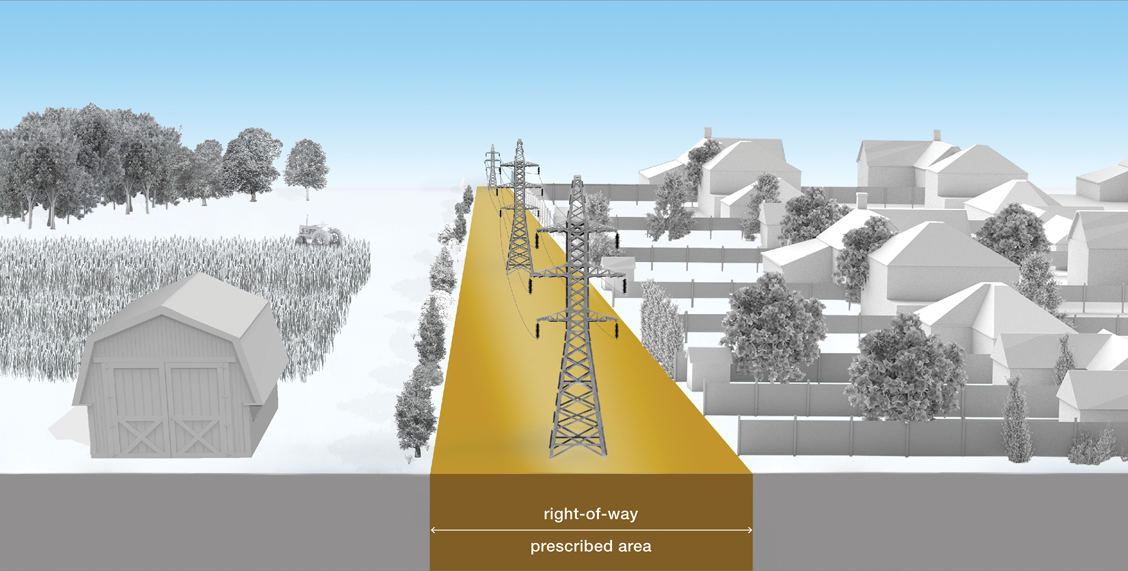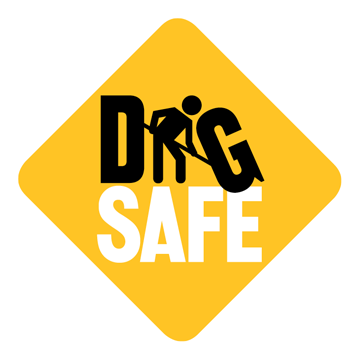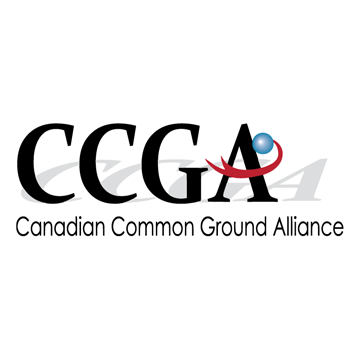Contractors and Landowners Near Power Lines

Who this page is for
This section is for any company, contractor, or person working near an international or interprovincial power line that is regulated by the Canada Energy Regulator (power line).
You must get written authorization for certain activities from the holder of a permit or certificate of an international or interprovincial power line (power line company).
Note: If you are working near any other kind of power line, you should consult your local laws and power authority about your obligations. This page applies to international power lines and interprovincial power lines that are regulated by the Canada Energy Regulator.
Refer to the following regulations:
- International and Interprovincial Power Line Damage Prevention Regulations – Authorizations (IPLDPR-A)
- International and Interprovincial Power Line Damage Prevention Regulations – Obligations of Holders of Permits and Certificates (IPLDPR-O)
On this page
- Activities that require authorization from the power line company
- Examples of activities and mobile equipment
- What is the prescribed area?
- Activities that need a locate request
- Ground disturbance
- Before you dig: information for those living and working near power lines
- What if plans change?
- Driving off a highway or public road
- Agreeing to activities with the power line company
- If you don’t follow the regulations
- Related regulations and links
- Damage prevention resources
Activities that require authorization from the power line company
- Ground disturbances within the prescribed area that are:
- 30 cm or deeper
- 45 cm or deeper for cultivation activities only
- do not reduce the depth of earth cover over the underground portion of a line
- do not add soil under an overhead power line or reduce ground to wire clearance
- Constructing a facility across, on, along, or under a power line (near a power line)
- Crossing a power line with vehicles or mobile equipment off a highway or public road
You have a duty to inform: you must give this information to anyone working on your behalf.
Examples of activities and mobile equipment
Examples of activities and mobile equipment that require authorization from the power line company include, but are not limited to:
- building roads
- building or maintaining water and sewage utilities
- building drainage projects
- ploughed-in pipe
- horizontal directional drilling
- planting trees
- building fences
- installing utility poles
- crossing a right of way or power line off a public road or highway with vehicles or mobile equipment
- building new or maintaining existing facilities
See examples of vehicles and mobile equipment that require authorization from the power line company...
Examples of vehicles and mobile equipment include, but are not limited to:
- augers
- bulldozers
- dump trucks
- backhoes
- graders
- trenchers
- cranes
You may or may not need authorization from the power line company to drive vehicles or mobile equipment on a highway or public road, depending upon your local laws and ordinances. For information about off-road driving, see Driving off a highway or public road.
What is the prescribed area?

Prescribed area description
The prescribed area is a strip of land on which an international or interprovincial power line is located, and that corresponds to the right of way (ROW) of that line. Where there is no ROW, the prescribed area is the strip of land extending 30 m on each side from the centre of the power line.
The prescribed area is an area where extra precautions and written authorization from the power line company are required before ground disturbance activities can occur.
The ROW for overhead power lines is generally obvious, and will be clear of trees or other structures that can contact the power line. The ROW for buried power lines or underground portion of a power line isn’t always as visible. If there is no ROW for the power line, the prescribed area is the strip of land 30 metres on each side from the center of the line.
Important: adding soil or other materials under an overhead power line is prohibited, unless the power line company agrees to this. Adding soil or other materials may reduce the ground to wire clearance below the required safe height.
Power line companies, pipeline companies, utilities, and governments across Canada support one-call centres. One-call centres notify registered members (example: power line and pipeline companies), who send out technicians to mark underground infrastructure in a planned work area. Go to Click Before You Dig for links to the one-call centre in your region. The IPLDPR-O regulations require that power lines must be located within 3 working days after the day on which the request is made.
For the regulations requirements, see:
- IPLDPR-A, section 2 – Prescribed Area
- IPLDPR-O, section 4 - Obligations Following Request to Locate
- IPLDPR-A, section 5 – Locate Request—Timing
Right of way (ROW) description
The right of way (ROW) is the land registered or recorded as the right of way in the land registry office. The width of the ROW varies according to the size, routing, and number of lines. If there is no ROW, the prescribed area is measured 30 m from the outermost centre of the power line on each side.
SAFETY WARNING: NEVER PLACE A METAL TAPE MEASURE OR ANYTHING ELSE WITHIN 3 M OF A MEDIUM-VOLTAGE LINE.
How soil depth affects your activities.
Ground settling, erosion, and other activities can reduce the soil depth over a buried power line or an underground portion of a power line from when it was originally built. As a result, regulations restrict ground disturbance activities such as excavating, digging, or augering 30 cm (12 in) and deeper in the prescribed area.
Activities that need a locate request
Contact Click Before You Dig, or contact the power line company directly, for a locate request at least 3 working days before the day on which the construction or activity is to start. You must make a locate request before you:
- construct a facility near an international or interprovincial power line (power line)
- do any work that causes a ground disturbance within:
- the prescribed area
- the power line ROW
- if there is no ROW, within the strip of land extending 30 m on each side from the centre of the power line)
You need to make a locate request before you:
- dig 30 cm (12 in) or deeper in the prescribed area
- cultivate 45 cm (18 in) or deeper in the prescribed area
Contact the power line company directly to:
- construct a facility on the right of way (ROW) or near a power line
- drive vehicles and mobile equipment across a power line off of a highway or public road
For details, see examples of activities and equipment
For the regulations requirements, read the following from IPLDPR-A:
- section 5 – Locate Request
- section 6 – Duty to Inform
- section 7 – Authorization – Of Construction of a Facility
- section 8 – Authorization – Of Ground Disturbance Activities
- section 9 – Authorization – Vehicle and mobile equipment
Ground disturbance
A ground disturbance is anything that penetrates the ground 30 cm or deeper, or that reduces earth cover over a buried power line or an underground portion of a power line.
See IPLDPR-A, section 3 (b) and section 8(3)(b) for details.
Read more details about ground disturbances.
Ground disturbance is any activity within the prescribed area that involves either:
- agricultural cultivation 45 cm (18 in) or deeper below the surface of the ground
- the soil otherwise being disturbed or displaced 30 cm (12 in) or deeper
- not reducing the depth of the earth cover over any underground portion of a line
If the activity reduces the current depth of earth cover over the power line, it is a ground disturbance regardless of its depth.
Activities
Activities in this case are anything that cause a ground disturbance. You must get authorization from the power line company for specific activities before you start.
For more information about ground disturbance activities, read the following:
- CCGA Damage Prevention Best Practices manual
- CSA Z247 Damage prevention for the protection of underground infrastructure standard
See examples of activities that require authorization.
- Digging by hand or machine
- Planting trees
- Digging fence posts
- Trenching
- Ditching
- Tunneling
- Plowing to install underground infrastructure
- Blasting/use of explosives
Construction of a Facility
Requirements for constructing a facility
When constructing a facility near a power line, you must:
- follow the technical details that the power line company included in their written authorization for construction
- comply with any conditions the power line company included in their authorization
- agree in writing to a procedure and schedule for the work
If you are building a facility across, on, along, or under the power line, you must get the power line company’s authorization in writing.
You must also meet the following requirements:
- for vehicle and mobile equipment crossings related to overhead power lines, follow CSA Group standard C22.3 No. 1 to cross portions of buried power lines, follow CSA Group standard C22.3 No. 7, Underground systems
Examples of facilities
Examples can include, but are not limited to:
- a structure (more examples are in structures)
- highway, private road, or railway
- irrigation ditch, drain, or drainage system
- sewer
- dike
- telephone line, telegraph line, telecommunication line
- line for the transmission of electricity
- a pipe for the transmission of hydrocarbons or any other substance
Structures
Some examples of structures include:
- fences
- outbuildings
- skating rinks
- swimming pools
- sheds
- gazebos
- woodpiles
- berms
- event tents
- any other structure
- placing or storing equipment (mobile or otherwise)
See IPLDPR-A section 7 – Authorization – of construction.
Before you dig: information for those living and working near power lines
Know what’s below. In addition to power lines, there may be other federally, provincially, and locally regulated buried infrastructure in your area. These may include power lines, distribution electrical cables, gas distribution systems, telecommunications or fibre-optic communications cables, and water and sewer lines.
See the steps to take before starting any activity that disturbs the soil 30 cm or deeper in the prescribed area.
Ground disturbance is any activity within the prescribed area that involves either:
- Don’t just dig. Plan ahead. It takes time to locate the cables and pipes and to get written authorization from the power line company.
- Look for indications of all buried infrastructure, like electric distribution pedestals or pipeline marker signs in your area, and check land records for easements.
- Contact Click Before You Dig or a one-call centre to locate underground cables and pipes. You may need to be on site when the technician comes.
- You have a duty to inform: you must give everyone the safety information they need: contractors, subcontractors, family members, volunteer helpers, and employees.
If the activity reduces the current depth of earth cover over the power line, it is a ground disturbance regardless of its depth.
What if plans change?
If plans change and you need to dig 30 cm (12 in) or deeper, or if your projects or work bring you closer to the power line, this is called a scope change.
Your original plans may not have required a locate if you weren’t digging deeper than 29 cm. However, if plans change and your ground disturbance activity will be 30 cm (12 in) or deeper, or will reduce the depth of earth cover over the power line to a depth that is less than the cover provided when the power line was constructed, or the work area extends closer to the power line, work must stop. Contact the power line company to advise them of the changes to the activity work area before you continue.
Driving off a highway or public road
You must have authorization from the power line company to drive vehicles and mobile equipment off of a road, across the power line.
Contact the power line company for help if the soil conditions pose a risk of ruts caused by vehicles or mobile equipment. Ruts that are 30 cm (12 in) or deeper are a ground disturbance. These ruts could affect the personal safety of staff, or damage the power line.
See IPLDPR-A, section 9 –Operation across a power line.
Agreeing to activities with the power line company
The CER encourages you and the power line company to agree to the following:
- the terms of work within the authorization to conduct specific activities
- construction of a facility across, on, along or under an international or interprovincial power line
- projects or work causing ground disturbance within the prescribed area
- crossing a power line with vehicles and mobile equipment off a public road or highway)
The power line company must give authorization for certain activities.
If you and the power line company cannot reach an agreement, you can both seek help from the CER.
Get help from the CER to reach agreements
If you and the power line company cannot reach an agreement, the CER can help. We offer 2 options to help you:
- Using Alternative Dispute Resolution to negotiate an agreement.
- Filing an application under Section 275 of the CER Act to address:
- ground disturbance in the prescribed area
- facility construction near international or interprovincial power lines in the ROW
- vehicle or mobile equipment crossing an international or interprovincial power line
Contact the CER for applications under the CER Act, Section 275.
Read about options for managing disagreements.
Using the CER’s Alternative Dispute Resolution service
If you and the power line company cannot come to an agreement, you can both contact the CER for assistance. We offer an Alternative Dispute Resolution (ADR) service, a voluntary and confidential way for those involved to resolve disputes. Both you and the power line company must agree to participate in ADR.
To learn more, visit Alternative Dispute Resolution.
If you don’t follow the regulations
If the CER Act and its regulations are not followed, critical safety issues may occur, either immediately or over time. For example, a person may strike the line while conducting an activity near a power line if they do not make a locate request or contact the power line company for details. The power line could electrocute you, or the coating on the power line may be damaged.
Violating the Act and its regulations can lead to fines and penalties. Damage to the power line must be reported to the power line company. The power line company must report damage to the CER.
Ensure you follow the regulations.
An activity is unauthorized and illegal if the regulations are not followed.
You must get authorization and safety information from the power line company for:
- an activity that causes a ground disturbance in the prescribed area
- constructing a facility near a power line
- driving across a power line off a roadway with vehicles or mobile equipment
The CER may enforce against unauthorized activities for the safety of all involved.
Court Action
Violations of CER can also lead to either a summary conviction or conviction on an indictment. The penalties for these convictions are:
- On conviction on indictment, to a fine not exceeding $1 million or to imprisonment for a term not exceeding 5 years or to both.
- On summary conviction, to a fine not exceeding $100, 000 and or to imprisonment for a term not exceeding 1 year or to both.
Click here for more information on enforcing the regulations.
Related regulations and links
- Canadian Energy Regulator Act:
- International and Interprovincial Power Line Damage Prevention Regulations – Authorizations, SOR/2019-347
- International and Interprovincial Power Line Damage Prevention Regulations – Obligations, SOR/2020-49
CER Pages
International Power Lines - Power Line Damage Prevention (Acts and Regs webpage)
Damage prevention resources
Organizations across Canada have joined to help you plan your work safely. The Canadian Common Ground Alliance (CCGA) provides a free, searchable online manual with damage prevention best practices for all buried infrastructure.
Click any of the logos below to visit their sites and find out how they can help you.
- Date modified:



